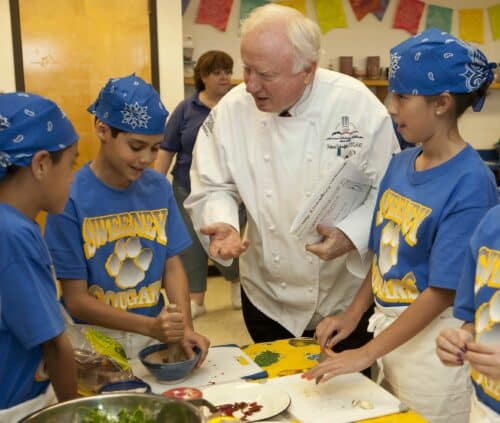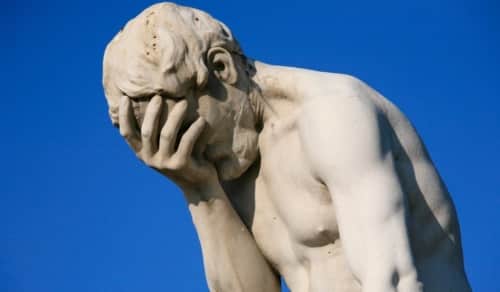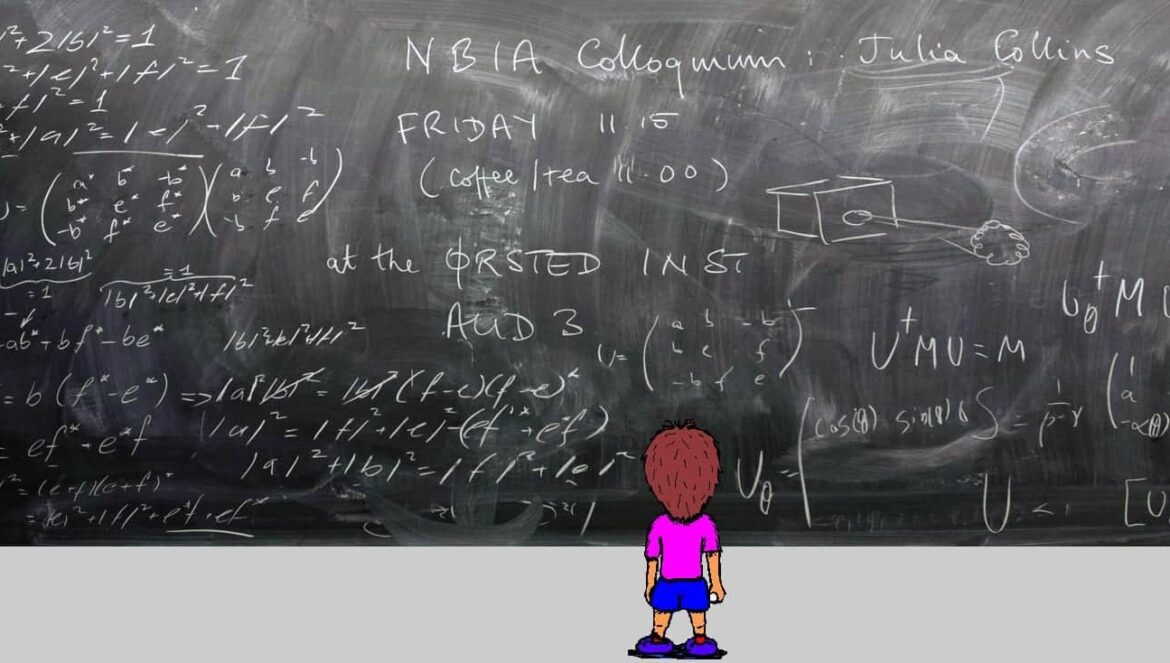“When am I ever going to use THIS?“
by Ed Thomas
Introduction: Many people have personal memories of studying math when they were in school. Do you have memories of some of the math classes you participated in as a child? I recently had an opportunity to survey a small group of adults regarding math topics they studied when they were in school. Specifically, I asked them to recall math topics that they studied in grades K-2, 3-5, 6-8, and 9-12. People’s answers included:
 K-2: Number symbols and names for numbers 1- 20, numbers and number lines, basic addition and subtraction
K-2: Number symbols and names for numbers 1- 20, numbers and number lines, basic addition and subtraction
3-5: Multiplication facts, multi-digit multiplication and long division,
6-8: Decimals, fractions, and negative numbers
9-12: Solving equations, proving geometry theorems, Pythagorean Theorem and trigonometric identities
These topics are typical items that traditionally appear on K-12 math curriculums. I also asked the adults: On a scale of 1 – 10, where 1 is almost never and 10 is almost always, to what degree did your math teachers demonstrate the relevance of math as it applies to you and your world? The number 2 was the highest answer given. If you were asked the same question, what would your answer be?
Math Curriculums
Throughout my teaching career, I taught from a variety of math curriculums. Every five to seven years, the math curriculum was replaced with a newer one. Math curriculums help teachers to know what they should teach their students. Math curriculums provide information teachers need to make important decisions regarding the planning, teaching, and assessment of mathematics.
So why are math curriculums frequently replaced with new ones? What makes a newer math curriculum better than the existing curriculum? Many educators believe that a newer math curriculum is better if the curriculum:
- Eliminates year-to-year redundancy,
- Raises the academic bar from grade level to grade level
- (for example, fraction concepts taught in the seventh grade are now taught in the fifth grade)
- Includes action words like demonstrate, understand, construct, or prove,
- Provides national consistency, and
- Promotes school and teacher accountability.
Many math educators would say that the Common Core Math Standards reflect these characteristics, and that is why many states and school districts adopted the Common Core Math Standards for their math curriculum.
As stated earlier, I dealt with a variety of math curriculums that were ushered in throughout my teaching career. While it can be argued that each curriculum was an improvement over its successor, a very important component was missing from each curriculum. The relevance of math, as it applies to the students’ world, was missing.
The Five Stages of Teaching and Learning Math
In the year 2000 I developed the Five Stages of Teaching and Learning Mathematics. The Five Stages include:
1) Knowledge (facts, vocabulary, and formulas),
2) Understanding (the ability to explain why math works),
3) Proficiency of Skills (mastery),
4) Application (problem solving), and
5) Retention (remembering math over time).
The Five Stages of Teaching and Learning Math served as an excellent guide for teachers who wanted a thorough approach to teaching math topics promoted by math curriculums. The fourth stage, Application, represents problem solving and learning experiences that help students to see the relevancy of math.
Virtually all the math we teach is relevant, and connects to the real world. Without relevancy, teachers run the risk of students viewing math as uninteresting, unimportant, and unnecessary. These feelings will negatively affect students’ motivation to participate in math and the learning process. The alternative is to regularly include relevant applications in math lessons and units.
Examples of Relevancy in Math
Let’s examine a few relevant applications that teachers can share with their students in grades K-2, 3-5, 6-8, and 9-12.
 Grades K-2
Grades K-2
Math topic: Counting and Ordering Numbers
Relevant Application: Calendars and Numbers
Calendars are readily available and often free. Many calendars are thematic and provide fantastic pictures of horses, cities, flowers, puppies and a wide variety of topics that can capture students’ interests. Most importantly, calendars use orderly sets of numbers to organize and identify the days of the week and month. Students can learn a great deal from the numbers on a calendar. Each day on a calendar presents new opportunities for students to learn and reinforce number concepts.
For example, assume the date of the current day is October 9. The teacher can make the following connections.
- Today’s date tells how many days of October have occurred.
- Let’s count the days from day 1 to today. Let’s count the days from today to the last day of the month.
- Today’s date is represented by an odd number. What is an odd number?
- Yesterday’s and tomorrow’s dates are even numbers. What is an even number?
- Note, the number 9 is ‘one more’ than 8, and ‘one less’ than 10.
- What number is 2 less than 9? What number is 2 more than 9?
- What was the date one week ago? What will the date be one week from now?
 Grades 3-5
Grades 3-5
Math topic: Understanding Fractions
Relevant Application: Working with Recipes
Problem: Marie has a recipe for salsa that she really likes. The recipe makes salsa for two people, and is shown below. Marie wants to expand the recipe so it makes enough salsa for six people. Work with a partner and modify the measures in the recipe so it will provide enough salsa for six people.
Salsa for Two Solution: Salsa for Six
3 1/2 cups of diced tomatoes 10 1/2 cups of diced tomatoes
1/4 cup of green bell pepper 3/4 cup of green bell pepper
3/8 cup of onion 1 1/8 cup of onion
1/2 teaspoon of black pepper 1 1/2 teaspoon of black pepper
2 tablespoons of lime juice 6 tablespoons of lime juice
Grades 6-8
Math topic: Linear Equations
Relevant Application: Celsius and Fahrenheit Conversion Formula
Problem: Celsius and Fahrenheit represent two different ways of measuring temperature. Fahrenheit scales are used in everyday life applications like TV weather reports, cooking and baking, and home thermostats. Celsius scales are used in science applications like astronomy, chemistry, and physics.
Water freezes at 32º F and 0º C. Water boils at 212º F and 100º C. Use this information and algebraic methods to develop a conversion formula between Celsius and Fahrenheit.
Solution: In algebra, a linear equation expresses the mathematical relationship between two sets of numbers X and Y. A linear equation can be created from two ordered pairs (x1, y1) and (x2, y2). Students can use the ordered pairs (32,0) and (212,100) to develop a linear equation or conversion formula between Celsius and Fahrenheit.
Create an equation of the form y = mx + b.
Note: Given (x1, y1) and (x2, y2), m= (y2 – y1) / (x2 – x1)
In this application, (x1, y1) = (32,0) and (x2 , y2) = (212,100)
(y2 – y1) / (x2 – x1) = (100 – 0) / (212 – 32) = 100 / 180 = 5/9 = m
y = mx + b ==> 0 = 5/9 (32) + b ==> b = – 160/9
Conversion formula: y = 5/9 x – 160/9 or C = 5/9 F – `160/9 or F = 9/5 C + 32
Grades 9-12
 Math topic: Probability
Math topic: Probability
Application: State Lotteries
Problem: A State lottery game features four canisters, each with 40 balls numbered 1 – 40. A lottery player pays $3.00 for a chance to play. To win, a player must pick four numbers that match the numbers on the four balls that are randomly ejected from the canisters. The player thinks his chance of winning is defined by the sum of the ratios 1 ball / 40 balls + 1 ball / 40 balls + 1 ball / 40 balls + 1 ball / 40 balls = 4 / 40 = 1 / 10 = a 10 percent chance of winning. The player is mistaken. Calculate the probability of winning at this game.
Solution: The study of mathematics teaches that the probability of an event occurring equals the ratio defined by (the number of favorable outcomes / the number of possible outcomes). The study of math also teaches that the probability of succeeding in multiple independent events = the product of the probabilities associated with the individual events.
In this lottery game the probability of selecting one of the four winning numbers from the first canister is 1/40 (Think: 1 favorable outcome and 40 possible outcomes). The probability of selecting the correct numbered ball from the second canister is also 1/40. The probability of selecting the correct numbered ball from the third canister is 1/40).
 Finally, the probability of selecting the correct numbered ball from the fourth canister is 1/40.
Finally, the probability of selecting the correct numbered ball from the fourth canister is 1/40.
The product of the probabilities of these independent events is 1/40 • 1/40 • 1/40 • 1/40 = 1 / 2,560,000. The probability of a player winning this lottery game is 1 chance out of two million, five-hundred sixty thousand. To put that in perspective, if a person played the game 2,560,000 times, they could expect to win once.
Adding Relevance to Math Lessons and Math Units
Math teachers often teach from curriculums that do not provide direction and information for teaching the relevancy of math. It is not likely that any of the applications shown above appear on any math curriculum. Nonetheless, these are excellent applications that can ignite students’ interest in math, and demonstrate the relevancy of math.
So what should a math teacher do?
- First, teachers should select and organize the lesson or unit content that follows the Five Stages of Teaching and Learning Math. Typical curriculum content will align well with the Knowledge and Proficiency of Skill stages. Math curriculums often skimp on activities that align with the Understanding and Applications stages. The Application stage will remind teachers to include problem-solving examples that highlight the relevancy of math.
- Second, math teachers should seek application ideas for the math they teach. Teachers can access great ideas through math-education conferences, professional development workshops, math education articles, and in-house or on-line discussions with colleagues.
- Third, math teachers should show their commitment to relevancy in math by including application questions on their unit tests. A great way to do that is to offer two or three application problems on the test, and allow students to choose and solve one. Through choice, teachers can connect with a variety of students’ interests.
Summary
While relevancy is not everything in math, it is a very important component of math. Without relevancy, students are likely to become disinterested in math, and devalue its importance in their world. Relevancy in math should be addressed through the Application stage of the Five Stages of Teaching and Learning Mathematics. Relevancy can be demonstrated through a variety of interesting and fun problem-solving challenges. While relevancy activities might be absent from many math curriculums, a wealth of math applications and relevant activities are available to teachers through a variety of instructional forums, print materials, and online resources.
Author
Further Reading
- The Detroit News – Pi Day equals never-ending fun in Metro Detroit
- The Salisbury Post – Students talk about making a positive impact at showcase
- Mother Nature Network – Why we need to make math relevant to kids
